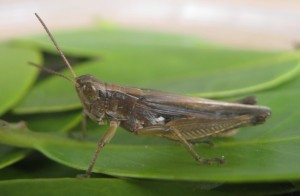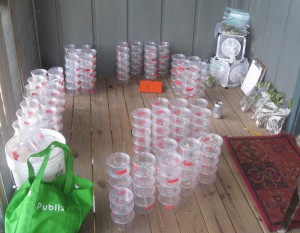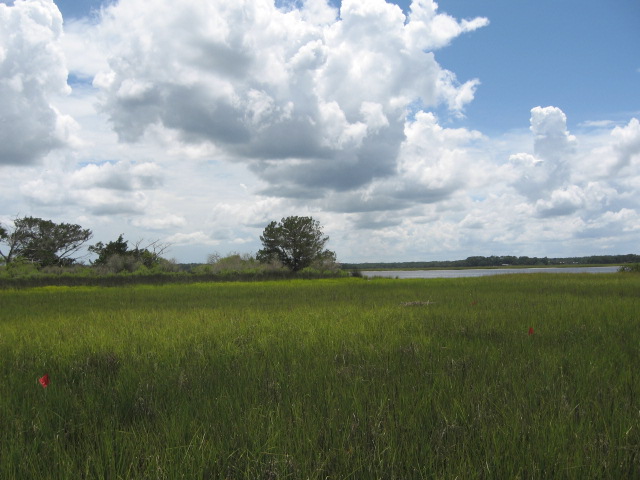by Lily Durkee

Spotted-winged grasshopper, one of two insect herbivores the team tested to see if they would eat mangrove leaves.
(Alex Forde/UMD)
My mentor, Alex Forde, and I were there conducting experiments for his dissertation and for my internship project. This whole summer we had been studying plant resistance to herbivores, so we were excited to document interactions between leaf-eating insects and black mangrove trees (Avicennia germinans) in Northern Florida salt marshes.
Over the past several decades, climate change has allowed black mangroves to move north along the Florida coastline. As a result, they are invading salt marshes and coming into contact with novel herbivores that are not common in mangrove forests further south. Depending on the behavior and food preferences of marsh herbivores, these species may affect how fast mangroves spread into salt marshes and where the trees are able to survive within marsh landscapes. Therefore, we wanted to test (1) whether salt marsh herbivores will eat mangrove leaves when marsh plants are also available, and (2) if salt marsh herbivores show a preference for leaves of different ages or for trees growing in different habitats.
More: How Florida mangroves are taking over marshes >>
To answer these questions, we decided to set up three tests. The first gave captive herbivores a choice between marsh grass and mangrove leaves, the second gave them a choice between old and young mangrove leaves, and the third exposed the herbivores to leaves from the different locations. After a set amount of time had elapsed, we would then measure how much of each kind of food they consumed.
First, though, we had to collect the herbivores. We decided to use two insect species, the seaside meadow katydid (Orchelimum fidicinium) and the spotted winged grasshopper (Orphulella pelidna), both abundant in salt marsh habitats. We went out into the marsh armed with sweep nets and plastic bags, and started hunting for grasshoppers and katydids. From preliminary work we knew that the seaside meadow katydid would readily chew on mangrove leaves, but we also decided to evaluate the spotted-winged grasshopper as a possible mangrove muncher. We decided that we would need to catch about 300 katydids and 100 grasshoppers for proper replication in the experiment.

“Katydid condos,” where the team fed insects marsh and mangrove plants to see which they liked better. (Alex Forde/UMD)
The third day was our “adventure” day. Alex and I hopped in his car and traveled down the coast of Florida, collecting leaves from mangrove seedlings growing in different habitats, ranging from salt marsh to mangrove forest. We first visited Gamble Rogers State Park, and I was amazed at the high density of black mangroves there, which was so different from GTM. We then went to marshes near Fort Matanzas and the Canaveral National Seashore, and ended at the Pine Island Conservation Area.
Canaveral was the worst, for sure. The moment we stepped out of the car we were swarmed by voracious mosquitoes. I kept telling myself, Anything for science! as I swatted bugs out of my face. My favorite, on the other hand, was Pine Island. We were greeted almost immediately by manatees in the river, a pleasant change from mosquito swarms. I was mesmerized by the huge, sleepy beasts, and Alex had to drag me away so we could collect leaves before the usual Floridian afternoon rain showers kicked in. The rain caught us anyway, but I’m glad it did, because as the sun came out, a giant double rainbow appeared in the east. It was stunning, and a perfect way to end the day.
The rest of the trip was spent working on the herbivore feeding experiment and finishing up data collection on field plots of mangrove seedlings. While I have not yet analyzed the data from the feeding experiment, I can already report an important observation: Marsh herbivores do feed on black mangrove leaves, whether or not salt marsh vegetation is present. Neat!
Lily Durkee is a senior at Montgomery Blair High School. She worked in Florida this summer with the University of Maryland, College Park, and the Smithsonian Environmental Research Center, tracking the northward spread of mangroves into salt marshes.
More first-hand stories from the mangroves >>



this is so wonderful! great job, Lily.
Love your writing style! Interesting, informative article.